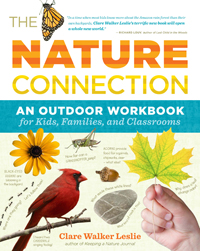I had the pleasure recently of attending a workshop led by naturalist Clare Walker Leslie, who is a prolific artist and author. Clare is a passionate proponent of art-based nature journalling, well-evidenced in her many journals. Seeing her journals is a delight – they are rich with drawings of the natural world, observations, and connections to her experiences. Her drawing style is beautiful – in some cases, quick and gestural to capture the shape of a bird before it flies off into the bush; in others, detailed, well-worked watercolours or coloured pencil drawings created in her studio from outdoor sketches and field guides. She spends a lot of time in classrooms with students, encouraging them to use drawing (or mark-making, as she prefers to call it) as a way to closely observe the flora and fauna around them – an important step towards developing their ecological literacy. Clare delivered three workshops in Toronto, including one at the Master of Teaching Environmental Education conference at OISE. It was refreshing to get outside – yes, even in a cold Ontario winter – just to draw, and to be reminded of the power of journaling as an ongoing learning activity for learners of all ages.  For more info on Clare, or to order one of her books, please visit her website at: Â
Art Education & Eco-Awareness
As part of a conference I presented at in the fall (All Hands in the Dirt, at Evergreen Brick Works) I was asked to present on how to keep students making art outside when the weather turns cold. That day we did some outdoor stenciling, but it reminded me of the power of taking art learners of all ages outside year-round to learn from the natural world. A colleague in the States, Heather Anderson, has written a new book on just this topic that’s worth a look: Art Education & Eco-Awareness: A Teacher’s Guide to Art and the Natural Environment. This resource is a compilation of art lessons on land, water, sky, plants and wildlife, all accompanied by colour illustrations of professional artists’ work on these themes and exemplars of children’s work. For those looking for new ideas to get your students outside to make art all year long, this is a great start. It’s available from Davis Publications:  Â

Maybe there’s something in the water in BC…
I had the pleasure of catching up with Lisa Lipsett recently, an artist from Salt Spring Island (on the West Coast of Canada) who is doing some fascinating work as an artist and educator in connecting to nature through art-making. (There seems to be lots of environmental art happening in British Columbia – may it’s all that makes for such fertile ground!) She’s designed a process she calls Creative Nature Connection, that is, in her words “a nature-inspired practice of artful connection to ourselves, each other and the world.” This is more than simply art-making in the great outdoors, but involves connecting to the self and with nature by “letting the inside out, and letting the outside in.” She’s written a book about this called Beauty Muse: Painting in Communion with Nature, and runs programs and workshops around the country as requested. She also has a terrific website, well-worth a visit to learn more about her approach. Find it at:

